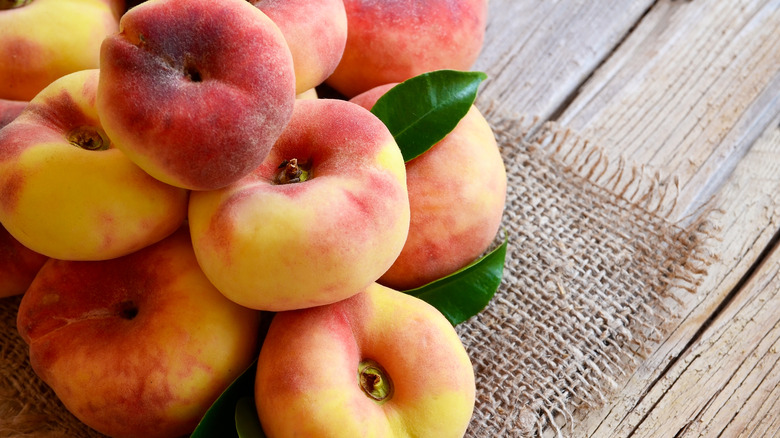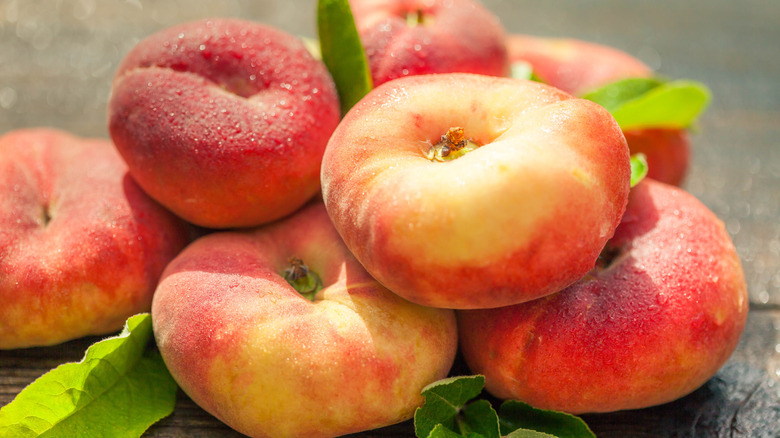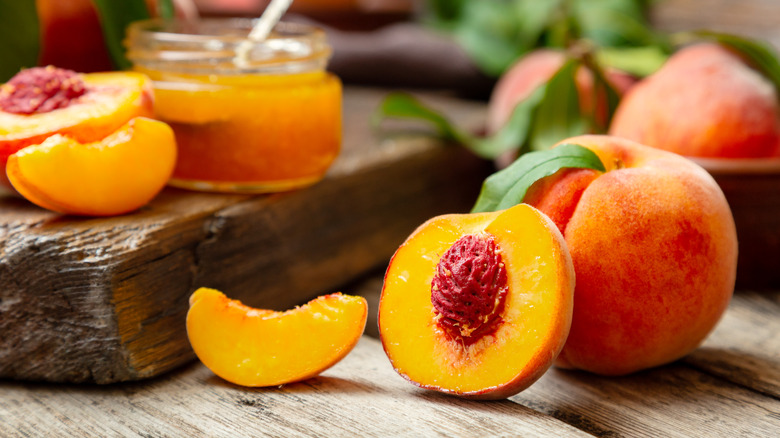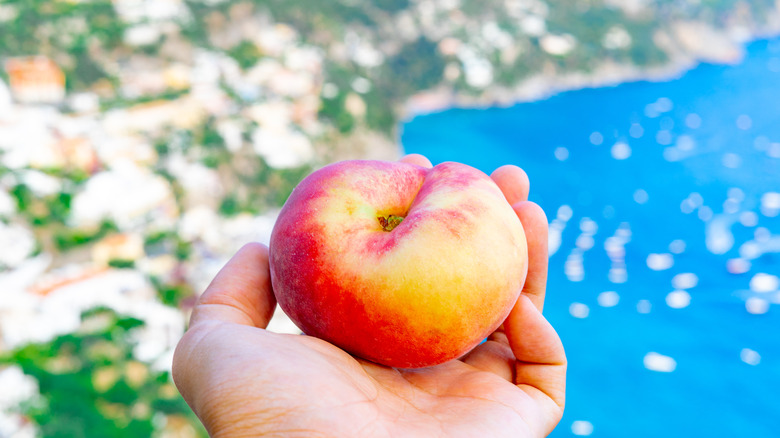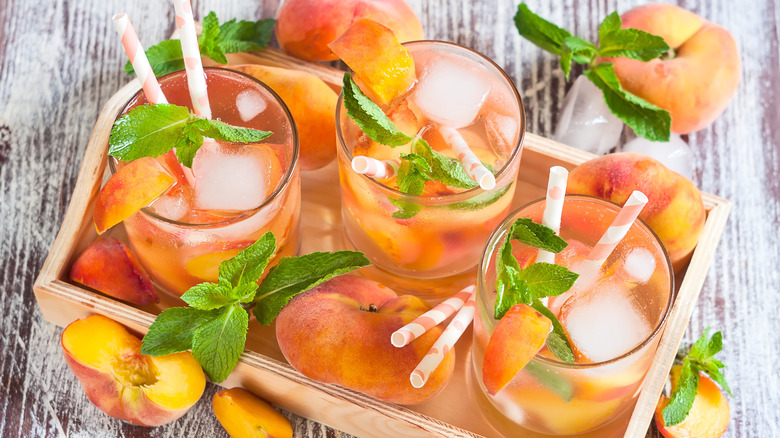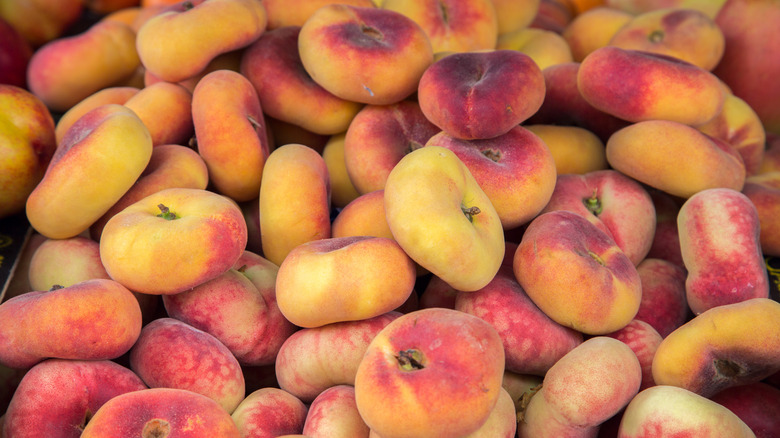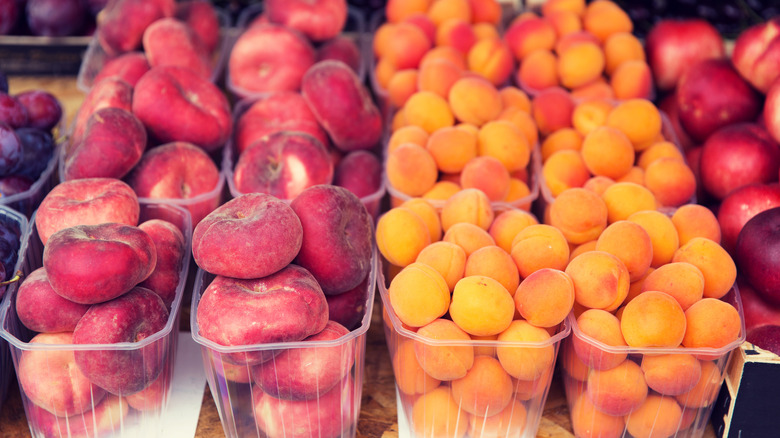What Makes Donut Peaches Unique?
If regular peaches are too big and juicy for you to handle (which honestly sounds like a good problem to have), you may want to turn your hands in the direction of the donut peach. Flatter and arguably cuter than other peaches, these little donut versions are also known as Saturn peaches due to their oblate shape.
In addition to their smushed appearance, donut peaches have quite a few distinctions from their other peach brethren. For instance, they aren't bright yellow, which is the most common peach color in the U.S., and they also have differences in flavor, texture, usage, and origin from many other types. But when it comes to donut peaches, don't judge a book by its cover — they may be funny-shaped, but once the late spring and summer roll around, we can bet you'll want to get your hands on one of these tasty flying saucers.
What are donut peaches?
Cultivated peaches go back almost 4,000 years and are one of China's oldest domesticated fruits. But the ancestors of donut peaches, first popped up in Chinese documentation in the 12th century B.C.E., when they were referred to as "Pan Tao" or "Peento." They didn't make it to the U.S. until the 1800s and didn't quite catch on at the time, potentially due to the American preference for yellow peaches. But in the 1960s and 1970s, scientists at Rutgers New Jersey Agricultural Experiment Station bred the fruits to be larger and sweeter, on sturdier trees that can resist frost.
Once the peaches were re-marketed with their current name and taken under the wing of Frieda's Specialty Produce in 1986, they began to take off in the U.S. — and now, the whole country can enjoy these unique fruits. Donut peaches, which are relatives of pears, apples, and blackberries, are typically about 2.5 inches in diameter and have a red, cream, and green skin. We know they're flatter than most peaches, but they also have a defining dimple at each end. And once you cut them open, you may be surprised to see that their insides, which surround a brown pit, are typically white.
The scientific name for the donut peach is prunus persica var. platycarpa. That's quite a mouthful, so feel free to call it by its other names: flat peach, UFO peach, galaxy peach, sweet bagel peach, or paraguayo peach, among others.
Donut peaches vs. yellow peaches
Just like donut peaches, yellow peaches originally came from China — but they took off in the U.S. much quicker than their flatter cousins. Peaches have symbolic importance in their native country and are thought to represent longevity and immortality. Eventually, yellow peaches traveled west, first to Persia, then Europe, Mexico, South America, and finally, to Virginia around 1600. They were mostly cultivated in New Jersey in the 1600s, giving the state the title "The Garden of the World," which may have led to the nickname "The Garden State."
The yellow variety that we commonly find in grocery stores in the States are called freestone peaches. Unlike donut peaches, they're big and round at up to 3.5 inches in diameter, and contain a pit that falls out easily. Yellow peaches are also darker than their donut cousins. As their name would suggest, they're typically a golden yellow on the inside and have fuzzy skin that ranges from red to orange to yellow. While donut peaches are beloved for their sweetness, yellow ones are known for having a full-bodied flavor with an equal balance of sweetness and acidity.
If you've ever eaten a big, juicy peach on its own, it was likely a freestone. These iconic summer fruits are perfect for eating as a snack or throwing in salads, yogurt bowls, or smoothies.
What do donut peaches taste like?
Not only are donut peaches some of the cutest peaches around, but they're also one of the sweetest. They've been described as having an almost candy-like sweetness, similar to a nectarine, due to their low acid to sugar ratio. And to make them even more unique, donut peaches have slight notes of almond flavors as well.
These flat fruits may not be quite as drip-down-your-chin juicy as the larger yellow peaches, but they can still hold their own when it comes to juice content — and they will be easier to eat on the go. Their skin isn't fuzzy, so you don't need to peel it like you would with other peaches, and their pits pop out fairly easily. And unlike bigger, rounder peaches, it's easy to take a bite out of these flying saucer-shaped fruits.
Before you dig into a donut peach, make sure to stop and smell the roses — which is a literal possibility, as these treats are known to give off a sweet, rose-like scent.
How to cook with donut peaches
You can use donut peaches in almost any recipe that calls for regular peaches — just keep in mind that since they're smaller than the big yellow variety, you may need a little more of them to hit the required peach content. They'll also bring a little extra sweetness to your recipe with slight hints of almond, although the nutty flavor should be subtle enough that it won't affect the overall taste of the dish. It's also be important to note that donut peach flesh is white, so don't count on them to add a yellow hue to your food.
Some of our favorite peach recipes include this classic peach cobbler, peach galette, and year-round peach pie. While sticking to these classic summer desserts is a safe bet, don't be afraid to branch out into peach syrup, smoothies, jam, ice cream, or mouth-watering grilled peaches — the donut variety can handle them all. And if you're really trying to think outside the box, try incorporating these fruits into recipes for peach salsa, fresh peach bellini cocktails, or slow cooker peach butter.
When cooking with donut peaches, make sure to handle them with care, as they can bruise easily.
Where to buy donut peaches
While these UFO-shaped peaches are undoubtedly unique, they may not be as difficult to find as you'd expect. Donut peaches have become increasingly popular in recent years, with Bon Appétit even calling the summer of 2018 "The Summer of the Donut Peach." We know you can typically find them at Trader Joe's, where they're called Saturn peaches, but they may also be available at other big chains like Vons, Albertsons, and Whole Foods.
When donut peaches are in season, from the late spring through the summer, they can often be found at farmer's markets and co-ops, where they're considered somewhat of a novelty item. They can be difficult for farmers to grow and harvest, as the fruits cling tightly to the branches and ripen quickly, so they may be pricier than your average peach.
Once you've secured the goods, you can leave your fruit on the counter to ripen for a few days if needed, as they'll keep for up to four days at room temperature. If you don't devour them right away, they'll also last in the fridge for up to two additional days.
Nutritional information about donut peaches
Sweet as they may be, with about 11 grams of sugar in every fruit, donut peaches are a highly nutritional food, just like the rest of their peach family. They're a good source of vitamins A and C, fiber, beta-carotene, potassium, fluoride, and iron, and they're rich in several antioxidants. These fruits are low in calories at approximately 50 calories a peach, and they have hardly any fat, cholesterol, or sodium.
Surprisingly, fresh and canned peaches appear to be similar in nutritional value, although fresh peaches have higher amounts of antioxidants. But in general, peaches are packed full of health benefits. According to Healthline, they may help healthy digestion, improve skin texture, reduce blood cholesterol levels, reduce allergy symptoms, and even help protect against some types of cancer. They're considered part of a "gastrointestinal soft diet," according to WebMD, meaning they can help soothe upset tummies. However, try to pace yourself when downing donut peaches, difficult as that may be – Lybrate shares that over-eating may cause bloat due to the gas they release in the large intestine.
Other varieties of donut peaches
While the original donut peach is flat and white on the inside, there are a plethora of different varieties that exist today — and they're not all white. In fact, Saturn peaches can have yellow skin, yellow insides, or stones that stick to the peach, which generally fall under the clingstone peach category. And all the different types are sold under a variety of fun names, including Flat Wonderfuls and Sauzee Swirls.
All donut peaches are flat and retain their signature flying saucer shape, but each type has slightly varying characteristics. For instance, Flat Wonderful peaches boast a vibrant red-orange color, ripen at the end of July, and are meant for canning, baking, or eating raw. Rutgers also trademarked a variety called BuenOs II peaches, which flaunt a bright red skin, are in season earlier in the summer, and have a "nice spicy flavor." And if you want to try a flat fruit that looks more like a Granny Smith apple than a peach, you may want to get your hands on the firm, light green TangOs II peaches.
To make it even more confusing, donut peaches in general go by a ton of different names — even more examples include the Chinese flat, peento, or Chinese saucer. Luckily, you don't need to remember all these titles in order to spot them, as the peaches' flat, donut shape should stand out easily enough.
